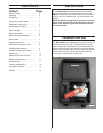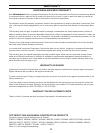
11
As concrete hydrates or cures and begins to set, it develops internal stresses which may cause random cracks. Random
cracks cast doubt on the quality and workmanship of the concrete. Contraction joints are cut in concrete to relieve these
stresses before they seek their own relief in the form of random crack. The Soff-Cut Ultra Early Entry system controls random
cracking through the early timing of a saw cut at predetermined locations to create weakened planes in the concrete that
subsequently crack at the bottom of the cut to relieve stress. Husqvarna sawed contraction joints should be a minimum of
1/8th the concrete depth and a minimum of 1” (25mm) deep. Contraction joints should be sawn as soon as the concrete will
support the weight of the saw and the operator without marking or damaging the concrete. There are many possibilities for
joint layout. Joint layout should be provided, the saw contractor should submit a detailed joint layout for approval prior to cut-
ting. Several factors affect joint spacing including:
• Concrete thickness
• Type, amount and location of reinforcement
• Shrinkage potential of concrete-cement (type, quantity), aggregate (size, quantity, quality), water to cement ratio,
admixtures, concrete temperature
• Base friction
• Slab restraints
• Layout of foundations, racks, pits, equipment pad, trenches, etc.
• Environmental factors - temperature, wind, humidity
• Methods and quality of concrete curing.
Generally, contraction joint patterns should divide slabs into approximate square panels per the recommended spacing
shown.
RECOMMENDED CONTRACTION JOINT SPACING
Concrete thickness, in. (mm) Maximum spacing, ft. (m)
3.5 (90) 8 (2.4)
4, 4.5 (100, 114) 10 (3.0)
5, 5.5 (125, 140) 12 (3.6)
6 (150) or greater 15 (4.5)
At all intersecting cross cuts, install Husqvarna joint protectors at each joint to prevent joint damage. Install an additional joint
protector where the right wheel will cross the joint to prevent concrete damage.
SAWING CONTRACTION JOINTS
TROUBLESHOOTING
ELECTRIC MOTOR WILL NOT START
- Check that the power cord is properly plugged into a
polarized outlet.
- Check that the power supply is sufcient to run 120V~60Hz,
12A equipments.
- Check the power cord for damage or cuts.
- Check that the extension cord is the proper wire size.
SAW IS SPALLING AND RAVELLING CUT
- Check to see if the diamond blade is worn out, glazed,
warped or damaged.
- Check to see if the spring loaded lower guard/skid plate
swings open freely without binding.
- Check skid plate for excessive wear or gap around the
diamond blade.
- Check bottom of skid plate for metal burrs or irregularities.
- Insure skid plate is not twisted or bent.
- Insure the skid plate is held at and rmly against the
concrete while cutting.
- Do not twist or move the saw sideways while cutting.
- Check that the electric motor is running smoothly and
properly.
- Check belt and belt idler for proper tension.
- Insure the diamond blade is properly mounted and secured
with clean anges.
- Insure that the diamond blade is the correct specication for
your area.
cont...
- Insure the slab is clean with no debris that could raise the
skid plate or saw while cutting.
- Use Husqvarna joint protectors at all cut intersections.
- Clean excess concrete debris from the blade guard
assembly.
- Hold down depth stop bolt while rotating the saw/blade out
of the cut.
- Do not stop the electric motor while the blade is in the cut.
















